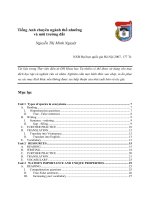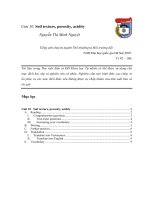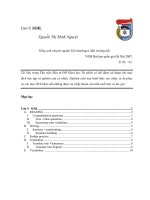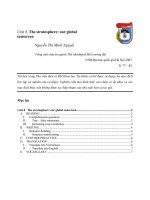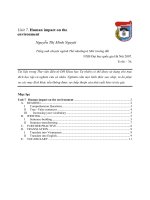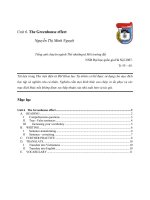Tiếng anh chuyên ngành Thổ nhưỡng và Môi trường đất phần 7 potx
Bạn đang xem bản rút gọn của tài liệu. Xem và tải ngay bản đầy đủ của tài liệu tại đây (214.39 KB, 12 trang )
Tiếng anh chuyên ngành Thổ nhưỡngvà Môi trường đất
NXB Đại học quốc gia Hà Nội 2007.
Tr 66 – 76.
Tài liệu trong Thư viện điện tử ĐH Khoa học Tự nhiên có thể được sử dụng cho mục
đích học tập và nghiên cứu cá nhân. Nghiêm cấm mọi hình thức sao chép, in ấn phục
vụ các mục đích khác nếu không được sự chấp thuận của nhà xuất bản và tác giả.
Mục lục
Unit 7 Human impact on the environment 2
A. READING 2
I Comprehension Questions 3
II True - False sentences 4
III Increasing your vocabulary 5
B. WRITING 5
I Sentence-building 5
II Sentence-transforming 7
C. FURTHER PRACTIVE 8
D. TRANSLATION 9
I Translate into Vietnamese 9
II Translate into English 9
E. VOCABULARY 11
Unit 7. Human impact on the
environment
Nguyễn Thị Minh Nguyệt
Unit 7
Human impact on the environment
A. READING
• Warm-up activities
- Where does air pollution mainly come from?
- What should we do to prevent pollution?
Air pollution is one of the most pervasive environmental problems because atmospheric
currents can carry contaminated air to every part of the globe. Most air pollution comes from
automobile emissions and from power plants that burn coal and oil to produce energy for
industrial and consumer use. Carbon dioxide and other harmful gases released into the air
from these sources adversely affect weather patterns and the health of people, animals, and
plants.
Industrialized nations produce most of the world’s air pollution. For example, although
the United States is home to just 5 percent of the world’s population, the country generates 22
percent of human-made carbon dioxide emissions and 19 percent of all greenhouse gases such
as carbon dioxide and methane. These emissions harm the environment by causing acidic rain
and global warming, and by depleting the protective ozone layer that surrounds the earth.
Acid rain, a serious threat around the world, occurs when sulfur dioxide and nitrogen
oxide emissions from automobiles and fossil fuel burning power plants fall back to Earth as
acidic precipitation.
Global warming is another negative by-product of air pollution, and although there is
debate about the sources of the problem, most scientists agree that the earth is heating up. One
of the principle causes is thought to be high atmospheric concentrations of gases such as carbon
dioxide and methane. These and related substances are called "greenhouse" gases because they
trap heat in the earth’s atmosphere instead of letting it radiate into space, thereby, raising air
temperature.
If the warming trend continues, glaciers would melt, causing sea levels to rise by as much as
65 centimeters, a depth that would inundate most coastal cities. Low-lying island nations would
disappear altogether, and fertile farmland would turn to desert.
Another serious problem related to air pollution is the shrinking of the atmospheric ozone
layer that blocks out dangerous ultraviolet (UV) light. First reported over Antarctica in the
1980s, ozone holes have since been detected over parts of North America and elsewhere. The
holes are created when ozone molecules are destroyed by chloroflourocarbons (CFCs),
chemicals that are used in refrigerants and aerosol containers and can drift into the upper
atmosphere if not properly contained.
Some scientists estimate that 60 percent of the ozone layer may already have been lost to
pollution, and that even a percent loss could add a total of 330,000 new cases of skin cancer
and 1.6 million cases of eye cataracts worldwide. The high levels of UV light that cause skin
cancer and eye problems may also harm plankton, the foundation of the food chain in oceans.
Serious declines in plankton levels could lead to catastrophic losses of other sea life.
(Taken from "Encarta-World Atlas", Microsoft 2000
®
)
I Comprehension Questions
Answer the questions
1. Where does most air pollution in the world originate from?
2. What are weather patterns and the health of people, animals, and plants affected by?
3. How do the human-made carbon dioxide emissions and greenhouse gases harm the
environment?
4. When does acid rain occur?
5. What is the main cause of global warming?
6. Why are carbon dioxide, methane and related substances called "greenhouse" gases?
7. What will happen if the warming trend continues?
8. How are the ozone holes created?
9. What substances are used in refrigerants and aerosol containers? Where can they go to if
they are not properly contained?
10. What do skin cancer and eye problems result from?
II True - False sentences
Decide whether the following statements are true "T", false "F" or there’s no information
given "N" according to the text. Correct the false statements.
Air pollution comes not only from automobile emissions but also from power
plants.
Developing countries produce air pollution greatly.
The United States’ population accounts for 5 percent of the world’s population.
Acid rain is a serious threat in industrialized nations.
Ozone layer is known as a protective layer for the earth.
People in industrialized countries as well as in less developed countries want to
reduce air pollution.
"Greenhouse" gases let heat in the earth’s atmosphere radiate into space .
When CFCs destroy ozone molecules, ozone holes are created.
Recently more than 330,000 new cases of skin cancer and 1.6 million cases of
eye cataracts worldwide have been reported.
Plankton is the foundation of the food chain in oceans.
III Increasing your vocabulary
Synonyms
Look at the text again and say which words or phrases have the same meaning as:
1. spreading throughout
2. originate from
3. unfavourably
4. cause damage
5. incidental product
6. cities near the beach
7. becoming smaller
8. move slowly
9. discover
10. disastrous
B. WRITING
I Sentence-building
Make necessary changes and additions to complete the following passage from the prompts
given below:
1. Environmental pollution / be / term / that / refer / all the ways / by which / people /
pollute / surroundings.
2. People / dirty / air / gases / smoke.
3. They / poison / water / too many / fertilizers / pesticides.
4. People / also / pollute / surroundings / various other ways.
5. For example, / they / ruin / natural beauty / scattering / junk / litter / the land / the water.
6. They / operate / machine / motor vehicles / that / fill / air / disturbing / noise.
7. Nearly / everyone / cause / pollution / some way.
8. Thus, / to end / or / great / reduce / pollution / immediately, / people / would / have / stop
/ using / many things / such / fertilizers / pesticides.
9. Governments / can / pass / laws / that / require / businesses / individuals / stop / or / cut
down on / polluting activities.
10. Individuals / groups of people / can / work / persuade / business / take action toward
reducing pollution.
II Sentence-transforming
Change the following sentences from active voice into passive voice and vice versa:
1. Too much fertilizers or pesticides can ruin soil.
Soil
2. Today, 75 percent of all the world’s energy is consumed by a quarter of the world’s
population.
A quarter of
3. Pollution can be gradually reduced in several ways.
People
4. Polluted water kills fish and other marine life.
Fish and other marine life
5. Much pollution is caused by things that benefit people.
Things
6. Greenpeace expects that hydrochloroflourocarbons (HCFCs) will come under strict
control at the parties to the Montreal Protocol in the next few years.
It
7. Ozone is considered a dangerous pollutant when it exists close to the ground.
People
8. Some factors may slow global warming.
Globe warming
9. The statistics in the text were supplied by the US Environmental Protection Agency.
The US Environmental Protection Agency
10. Rain washes pollutants out of the air and deposits them on the land and in bodies of
water.
Pollutants
C. FURTHER PRACTIVE
Exercise 1: Choose one of the words or phrases below to fill in each gap in the
following passage. Each word or phrase is used once only.
affected danger on grow during
pollution polluted reduce major simple
pollutants thing for increase problem
change cities development the areas
People have always (1) their surroundings. But throughout much of
history, pollution was not a major (2) .Most people lived in uncrowded rural
areas, and the (3) they produced were widely scattered. People had no
pollution-causing machines or motor vehicles. The (4) of crowded industrial cities
in the 1700s and 1800s made pollution a (5) problem. People and factories in
these cities put huge amounts of pollutants into small areas. (6) the 1900s,
urban areas continued to develop and other new inventions made pollution steadily worse. By
the mid-1900s, pollution had (7) the water in every major lake and river and
the air over every city in (8) United States and other industrial countries. Since
the late 1960s, millions of people have become alarmed by the (9) of
pollution. Large numbers of people are now working to (10) pollution.
(Taken from "English-Vietnamese Translation Materials
for Advanced Students of English" by Alan Mc Gowan and Jack Hudson)
Exercise 2: Read the following passage. Put the correct word from the list below in
each blank. You may use some words more than one.
so so much so many too too much too many enough
We are all slowly destroying the earth. The seas and rivers are (1) dirty to swim
in. There is (2) smoke in the air that it is unhealthy to live in many of the world’s
cities. In one well-known city, for example, poisonous gases from cars pollute the air
(3) that traffic policemen have to wear oxygen masks.
We have cut down (4) trees that are now vast areas of wasteland all over the
world. As a result, farmers in parts of Africa cannot grow (5) to eat. In certain
countries in Asia, there is (6) little rice. Moreover, we do not take (7)
care of the countryside. Wild animals are quickly disappearing. For instance, tigers are rare in
India now because we have killed (8) for them to survive. However, it isn’t
(9) simply to talk about the problem. We must act now before it is (10)
late to do anything about it. Join us now. Save the Earth. This is (11) important to
ignore.
(Taken from "Longman Texts in Context" by Heaton J. B)
D. TRANSLATION
I Translate into Vietnamese
The greenhouse effect is not a new phenomenon. Scientists have known centuries that a
layer of gases naturally surrounds the earth like an insulting blanket, trapping the reflected
energy of the sun and preventing it from escaping into space. That is what makes the earth
warm enough for people, plants and animals. However, recent human activity has boosted
concentrations of greenhouse gases and enhanced their heat-trapping ability. The main culprit
is carbon dioxide (CO
2
) which scientists estimate amounts for nearly half of global warming.
CO
2
is released from burning fossil fuels (coal, oil and gas) and from clearing and burning
forests.
There are other important greenhouse gases too and they cannot be ignored – CFCs, for
example, may account for 25 per cent of global warming in the next century if their
production is not scaled back. But CO
2
is the pivotal one. The UN International Panel on
Climatic Change now says that CO
2
levels could double within 40 years if present rates of
fossil-fuel burning and deforestation continue. That could mean an average temperature
increase between two and four degrees centigrade and a sea-level of perhaps a foot by 2050.
(Taken from "Passport to ILTS" by Diana Hopkins & Mark Nettle)
II Translate into English
1. Người ta đã ước tính được rằng 50% sự ô nhiễm khí quyển và 20% của hiện tượng hiệu
ứng nhà kính trên thế giới là do các loại xe có động cơ gây ra. Để bảo tồn năng lượng,
giảm thiểu sự ô nhiễm không khí và những ảnh hưởng mang tính toàn cầu của sự ô
nhiễm này thì việc chuyển các loại xe chạy bằng động cơ đi-e-zen sang loại xe chạy
bằng điện là vô cùng cần thiết.
2. Ô-zôn được tạo thành từ ba nguyên tử ô-xy, trái với hai nguyên tử ô-xy có mặt trong
khí ô-xy mà chúng ta vẫn cần để thở. Bản thân ô-zôn rất độc hại và nó được xem như là
một chất gây ô nhiễm nguy hại nếu như nó tồn tại gần mặt đất. Trên tầng bình lưu, ô-
zôn thực hiện một chức năng rất quan trọng đối với cuộc sống trên trái đất. ở đó, ô-zôn
sẽ chắn bức xạ cực tím và bảo vệ trái đất khỏi bức xạ (nhiệt) mặt trời. Những ảnh hưởng
của việc suy giảm tầng ô-zôn bao gồm:
tỉ lệ ung thư da cao hơn
nhiều bệnh về mắt hơn (gồm cả bệnh đục thuỷ tinh thể)
giảm hệ thống miễn dịch ở con người
phá huỷ sự sống dưới nước và hệ sinh thái
gây thiệt hại cho nông nghiệp và các loài thực vật tự nhiên
tăng hiện tượng hiệu ứng nhà kính tự nhiên
thay đổi nhiệt độ của khí quyển.
E. VOCABULARY
adversely (adv) : bất lợi, có hại
atmospheric current (n) : luồng khí
automobile emissions (n) : khí thải từ các loại xe có động cơ
by-product (n) : sản phẩm phụ
cataract (n) : bệnh đục thuỷ tinh thể
catastrophic (adj) : thảm hoạ, tai biến
debate (v) : bàn luận, tranh cãi, suy nghĩ, cân nhắc
detect (v) : khám phá ra, phát hiện
diesel-propelled car (n) : xe chạy bằng động cơ đi-e-zen
drift (v) : trôi dạt
electric car (n) : xe (chạy bằng) điện
environmental protection (n) : việc bảo vệ môi sinh
food chain (n) : chuỗi thức ăn
glacier (n) : sông băng
hemisphere (n) : bán cầu
human immune system (n) : hệ thống miễn dịch ở con người
inundate (v) : ngập tràn, ngập lụt
oxygen atom (n) : nguyên tử ô-xy
oxygen mask (n) : mặt nạ ô-xy
ozone depletion (n) : sự suy giảm tầng ô-zôn
ozone molecule (n) : phân tử ô-zôn
pervasive (adj) : tràn ngập, toả khắp
plankton (n) : sinh vật trôi nổi
precipitation (n) : (lượng) mưa, tuyết
radiate (v) : toả ra, phát ra
rare (adj) : hiếm
screen (v) : che, chắn
shield (v) : bảo vệ
trap (v) : giữ lại, không thoát ra được
wasteland (n) : vùng đất hoang


